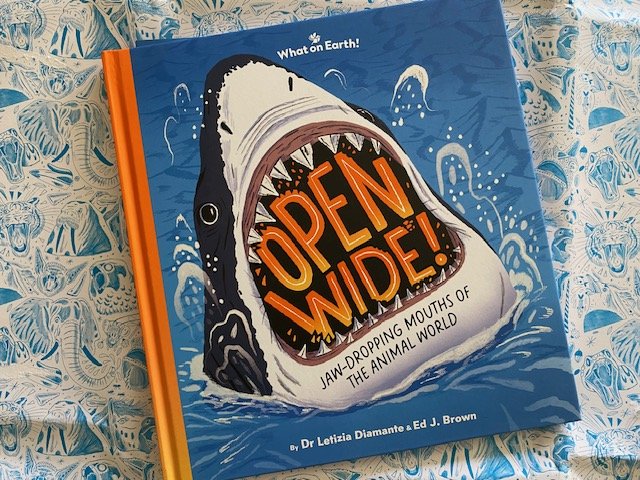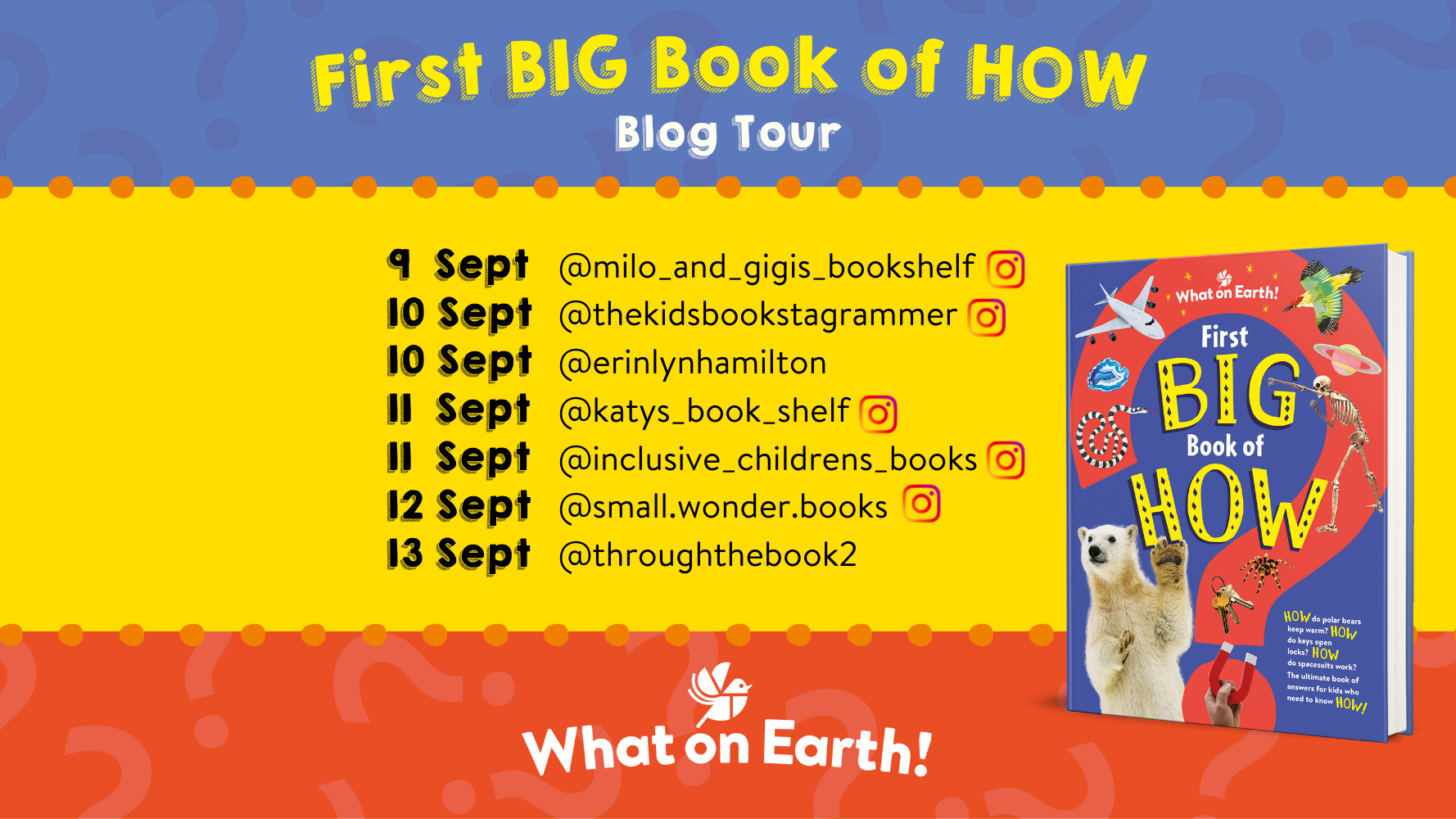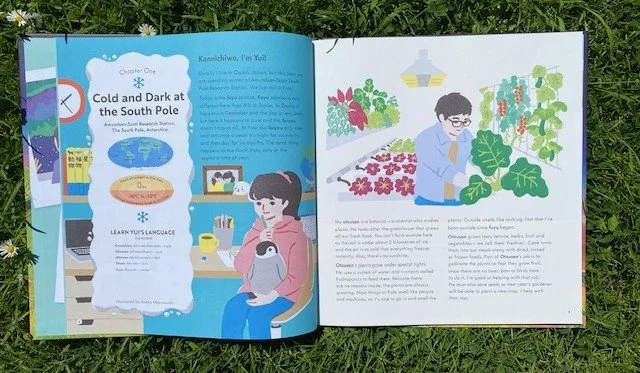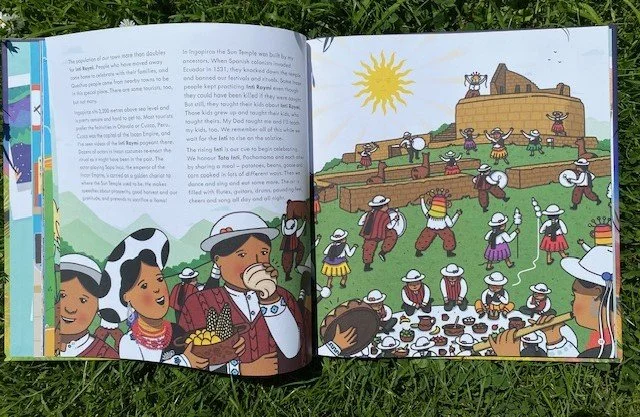
Reviews
There are so many incredible books available at the moment that it is impossible to read them all, no matter how hard I try! Here are my thoughts about some of the books I have read and how I think they could be used in school as well as Q and A sessions with authors and illustrators.
Blog Tour: Open Wide!
Today, it’s my turn to dive into the ‘jaw-dropping mouths of the animal world’ on the ‘Open Wide!’ Blog Tour.
Let’s start by asking a few questions. Do you know which creature has fangs that fold flat to stop it accidentally biting itself? No? What about which creature can extend its tongue one-and-a-half times its body length? Me neither! If you don’t know, then this is the book you need!
From its tasty introduction onwards, ‘Open Wide!’ is bursting with those quirky and fascinating facts which children love to discover and share! Starting with human teeth (Science NC Y4: identify the different types of teeth in humans and their simple functions), the book moves to the commonalities of mammalian mouths before moving on to the eating habits of slugs and snails. I now know what a ‘radula’ is!
The contents page is full of tempting titles like ‘Tremendous Tusks’ and Gigantic Grins’, making the book perfect for dipping in and out of: however, it is very easy to be led from page to page as there are intriguing questions posed at the bottom of some which you just have to turn over to find the answer to! I wanted to know if I was right about how the Barbary macaques were feeling -I wasn’t!- but I was more successful with guessing which coloured tongue belonged to which animal.
Whilst the book is mainly illustrated by Ed J Brown, some photographs are also included, allowing children to see the sucker of a goby and krill up close amongst other things. One of the most popular features of the text will no doubt be the ‘Not for the Squeamish’ fact boxes which regularly appear containing those disgusting facts which children love to quote- usually in the middle of a lesson!
Having both an index and glossary, ‘Open Wide!’ will be a useful resource for teachers keen to enrich the science curriculum with fascinating facts about teeth, diet, food chains, habitats etc, perhaps using the quiz sheet available on the ‘What on Earth’ website along with some other resources for this title.
A really absorbing read!
Open Wide!
Dr Letizia Diamante and Ed J Brown
What on Earth ISBN: 978-1804661352
Blog Tour: First Big Book of How
I am delighted to be taking part in the Blog Tour for ‘First Big Book of How’! Children are always bursting with natural curiosity about the world around them and this beautifully presented, chunky volume is the perfect place for them to find the answers they are looking for!
The book is divided into six clear sections: The Body, Machines and Buildings, Wild Animals, Bugs and Creepy Crawlies, Earth and Space. A contents page lists all the questions posed in each section and there is a comprehensive index at the end to help locate specific information, but this is a book which is perfect for browsing! A clear explanation is given in answer to each question, using straightforward language and in a good sized font, making it perfect for younger readers. Technical terms are explained within the text and a glossary at the back of the book offers further definitions. Fact boxes and diagrams add further details.
A lot of thought has been given to the presentation of this book. ‘Wow! What’s that?’ spreads are scattered throughout, showing close up images, offering a fascinating look at various things like the tongue or a dragonfly. Other spreads are called ‘Tell me how…now!’ which pose and answer specific questions- a chameleon’s tongue is up to 20cm long, the oldest tree in the world is almost 5000 years old, 280 people have been to the International Space Station… There is so much to learn here!
Some of the facts are truly disgusting- bogies can be green, brown or even pink depending on what’s trapped in it- which is sure to add to their appeal! There are questions here which you don’t know you want the answers to until you see them! How do worms know where they are going? Now I know! This is the sort of book which offers endless entertainment as it will be returned to again and again, allowing readers to share gleaned gems of knowledge. There is much in here which supports topics covered in the school curriculum, making it a useful book for home and school!
Illustrated with an appealing mix of photographs and pictures, ‘First Big Book of How’ is a real treasure trove of knowledge and discovery.
First Big Book of How
Sally Symes and Saranne Taylor, illustrated by Kate Slater
What on Earth ISBN: 978-1804661185
Solstice
Using solstice celebrations to take the reader on a journey around the world, this lovely book introduces fourteen fictional children from fourteen different locations as they experience the summer solstice. Whilst those living in the top half of the world have the longest day of the year, those in the bottom half experience the shortest, offering a fantastic snapshot of life around the Earth.
‘Solstice’ is a joy to read. Taken on a trip around the world, the reader is invited to share the daily lives of each child and discover, not only what happens on the solstice, but also something of the similarities and differences of those living in different locations. Each chapter starts with a map of the world showing where the child lives, the hours of sunlight on the 21st June and the average temperature range in addition to a small glossary featuring a selection of vocabulary with definitions used in the following text.
Each child then recounts their day, sharing cultural details about traditions and festivals as well as things about their daily routine. Kjersti from Svalbard, for example, comments on how normal it is for her that the sun doesn’t set and that she can sometimes see polar bears from her windows whilst for Bahasa, living in a city on the equator, the day is the same length all year round. Each section is illustrated by an artist with a connection to that country, making for a pleasing range of styles throughout the book. A section at the end of the book shows photos of each illustrator and offers a short autobiography. There is also a glossary of terms for the book as a whole and an index, making it easy to locate relevant information.
An excellent text to support the science and geography curriculum, ‘Solstice’ is also perfect for browsing at leisure.
Solstice: Around the World on the Longest, Shortest Day.
Jen Breach, illustrated by 14 global artists
What on Earth ISBN: 978-1913750770
NNFN2023: Evolution
Written in association with the Natural History Museum, ‘Evolution’ is the creation of ‘real life’ scientists, Sarah Darwin, great-great-granddaughter of Charles Darwin, and Eva Maria Sadowski. It is a completely engrossing read, supported by engaging illustrations and is the perfect text for supporting in Year 6 with the ‘Evolution and Inheritance’ strands of the science curriculum.
Each spread is packed with fascinating facts, starting with the work of Darwin and Wallace, but recognising and valuing the contributions of other ‘Pioneering People’. Concepts are clearly and concisely explained, with headings and sub-headings signposting readers to relevant sections. A comprehensive glossary explains some of the technical vocabulary used and there is a section which offers selected sources for each chapter, developing understanding of the research and fact checking which needs to be undertaken to write a book like this.
On pages which focus on a particular period, a timeline runs along the bottom of the page, allowing readers to locate when the events described in the text occurred. ‘Evolution’ really delivers an ‘exhilarating journey’, offering so much to discuss and enjoy!
Evolution
Sarah Darwin and Eva-Maria Sadowski, illustrated by Olga Baumert
What on Earth Books ISBN: 978-1912920532
Blog Tour: How to Chat Chicken
With the help of this book, you can become like Dr Doolittle and talk with the animals-gossip gorilla, babble bee, gab gecko or chat chicken as the fancy takes you!
The lively introduction from author, Dr Nick Crumpton, sets the tone for the book perfectly, encouraging readers to listen to, and observe, their pets and other animals carefully so that they can communicate with them.
Six sections- Prattling with Primates, Noisy Neighbours, Murmuring Minibeasts, Commotion in the Ocean, Wild Words and Wild on the Wing- are bursting with descriptions of how creatures communicate. Cats use chirruping noises when they are excited, croaking gourami fish make frog-like sounds to attract a potential partner and adult crows use a cooing noise to calm their young. It’s a fascinating read and sure to have everyone attempting to chat to the animals around them- and sharing their new found knowledge with anyone who will listen! A wonderful range of creatures is covered with careful explanations, not shying away from the use of technical vocabulary such as stridulation and pheromones which is explained in the glossary. The book also considers how some animals communicate in other ways, such as by the use of smell- and even the use of dialects in some species.
The bright, cartoon-style illustrations are very appealing and easy to dip in and out of. An index makes it easy to locate specific animals, but it is very easy to find yourself reading this one from cover to cover! As National Non-Fiction November approaches (but also at any time of the year!), it is great to remember that there are all styles of information texts to appeal to all styles of readers of all ages. There is as much to engage the 70 year old as the 7 year old here! Any book which encourages children (or any reader!) to really understand their fellow creatures and develop a sense of empathy and understanding can only be a good one!
How to Chat Chicken
Dr Nick Crumpton, illustrated by Adrienne Barman
What On Earth Books ISBN: 978-1804660423
Make sure you take a look at the rest of the stops on the Blog Tour! Many thanks to What on Earth for inviting me to be part it!











